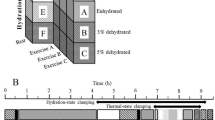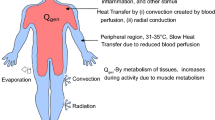Abstract
A model of the human body that integrates the variables involved in temperature regulation and blood gas transport within the cardiovascular and respiratory systems is presented here. It expands upon previous work to describe the competition between skin and muscles when both require increased blood flows during exercise and/or heat stress. First, a detailed study of the control relations used to predict skin blood flow was undertaken. Four other control relations employed in the model were also examined and modified as indicated by empirical results found in literature. Internal responses to exercise and/or heat stress can affect both thermoregulation and the cardiorespiratory system. Dehydration was studied in addition to complete water replacement during similar environmental and exercise situations. Control relations for skin blood flow and evaporative heat loss were modified and a water balance was added to study how the loss of water through sweat can be limiting. Runoff from sweating as a function of relative humidity was introduced along with evaporation, and these results were compared to data to validate the model. © 2000 Biomedical Engineering Society.
PAC00: 8719Pp, 8719Uv, 8719Ff, 8710+e
Similar content being viewed by others
References
Astrand, P. O., and K. Rodahl. Textbook of Work Physiology: Physiological Bases of Exercise, 2nd ed. New York: McGraw-Hill Book, 1977, p. 529.
Brobeck, J. T. Energy exchange. In: Medical Physiology, 13th ed., edited by V. B. Mountcastle. St. Louis: C. V. Mosby, 1974, pp. 1237–1252.
Comroe, J. H., R. E. Forster, A. B. Dubois, W. A. Briscoe, and E. Carlsen. The Lung, 2nd ed., Chicago: Year Book, 1963, p. 154.
Downey, D. D. A Coupled Model of the Cardiorespiratory and Thermoregulatory Systems. MS Thesis, Iowa State University, 1996.
Downey, D. D. Development of a Coupled Model of the Cardiorespiratory and Thermoregulatory Systems, PhD Thesis, Iowa State University, 1998.
Duffin, J.A mathematical model of the chemoreflex control of ventilation. Respir. Physiol.15:277-301, 1972.
Felder, R. M., and R. W. Rousseau. Elementary Principles of Chemical Processes, 2nd ed. New York: Wiley Series in Chemical Engineering, 1986, pp. 232–235.
Hortsman, D. H., and S. M. Horvath. Cardiovascular and temperature regulatory changes during progressive dehydration and euhydration. J. Appl. Physiol.33(4):446-50, 1972.
Kelman, R. G. Digital computer subroutine for the conversion of oxygen tension into saturation. J. Appl. Physiol.21(4):1375-1376, 1966.
Meade, F.Correspondence to proceedings of the anaesthetic research society London Hospital meeting: April 14, 1972, abstracts of work completed and in progress. Br. J. Anaesth.44:630, 1972.
Mitchell, D., L. C. Senay, C. H. Wyndham, A. J. Van Rensburg, G. G. Rogers, and N. B. Strydom. Acclimatization in a hot, humid environment: energy exchange, body temperature, and sweating. J. Appl. Physiol.40(5):768-778, 1976.
Mitchell, J. W. Energy exchanges during exercise. In: Problems with Temperature Regulation During Exercise, edited by E. R. Nadel. New York: Academic, 1977, pp. 11–26.
Nadel, E. R., J. W. Mitchell, and J. A. J. Stolwijk. Control of local and total sweating during exercise transients. Int. J. Biometeor.15(2–4):201-206, 1971.
Rowell, L. B.Human cardiovascular adjustments to exercise and thermal stress. Physiol. Rev.54(1):75-159, 1974.
Rowell, L. B. Human Circulation Regulation During Physical Stress. Oxford: Oxford University Press, 1986.
Saltin, B., A. P. Gagge, and J. A. J. Stolwijk. Muscle temperature during submaximal exercise. J. Appl. Physiol.25(6):679-688, 1968.
Seagrave, R. C. Biomedical Applications of Heat and Mass Transfer. Ames, IA: Iowa State University Press, 1971.
Senay, L. C.Plasma volumes and constituents of heat-exposed men before and after acclimatization. J. Appl. Physiol.38(4):570-575, 1975.
Stolwijk, J. A. J., B. Saltin, and A. P. Gagge. Physiological factors associated with sweating during exercise. Aerosp. Med.39:1101-1105, 1968.
Thomas, L. J.Algorithms for selected blood acid-base and blood gas calculations. J. Appl. Physiol.33(1):154-158, 1972.
Wills, N., M. C. C. Clapham, and W. W. Mapleson, Additional blood gas variables for the rational control of oxygen therapy with allowance for shifts of the oxygen dissociation curve. Br. J. Anaesth.59:1160-1170, 1987.
Rights and permissions
About this article
Cite this article
Downey, D., Seagrave, R.C. Mathematical Modeling of the Human Body During Water Replacement and Dehydration: Body Water Changes. Annals of Biomedical Engineering 28, 278–290 (2000). https://doi.org/10.1114/1.267
Issue Date:
DOI: https://doi.org/10.1114/1.267




